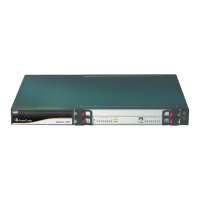User's Manual 572 Document #: LTRT-89730
Mediant 3000
28.9.2 Interworking SIP Diversion and History-Info Headers
This device can be configured to interwork between the SIP Diversion and History-Info
headers. This is important, for example, to networks that support the Diversion header but
not the History-Info header, or vice versa. Therefore, mapping between these headers is
crucial for preserving the information in the SIP dialog regarding how and why (e.g., call
redirection) the call arrived at a certain SIP UA. If the Diversion header is used, you can
specify the URI type (e.g., "tel:") to use in the header, using the SBCDiversionUriType
parameter.
This feature is configured in the IP Profile table (IPProfile parameter) using the following
parameters:
SBCDiversionMode - defines the device's handling of the Diversion header
SBCHistoryInfoMode - defines the device’s handling of the History-Info header
The handling of the SIP Diversion and History-Info headers is described in the table below:
Table 28-1: Handling of SIP Diversion and History-Info Headers
Parameter Value SIP Header Present in Received SIP Message
Diversion History-Info Diversion and History-Info
HistoryInfoMode = Add
DiversionMode = Remove
Diversion
converted to
History-Info.
Diversion removed.
Not present Diversion removed.
HistoryInfoMode =
Remove
DiversionMode = Add
Not present. History-Info
converted to
Diversion.
History-Info
removed.
History-Info added to Diversion.
History-Info removed.
HistoryInfoMode =
Disable
DiversionMode = Add
Diversion
converted to
History-Info.
Not present. Diversion added to History-Info.
HistoryInfoMode =
Disable
DiversionMode = Add
Not present. History-Info
converted to
Diversion.
History-Info added to Diversion.
HistoryInfoMode = Add
DiversionMode = Add
Diversion
converted to
History-Info.
History-Info
converted to
Diversion.
Headers are synced and sent.
HistoryInfoMode =
Remove
DiversionMode = Remove
Diversion removed.
History-Info
removed.
Both removed.
28.9.3 Interworking SIP REFER Messages
The device supports interworking of SIP REFER messages. SIP UAs may support different
versions of the REFER standard while others may not even support REFER.
This feature supports the following:
Attended, unattended, and semi-attended call transfers
Sending INVITE, REFER-notifications, BYE, PRACK and Session Timer on behalf of
peer PBXs

